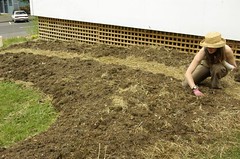 Image by Samuel Mann via FlickrOne of the methods discussed in some of my intensive gardening books is no-dig gardening. The idea of no-dig gardening was developed by an Australian named Esther Deans. It was originally both developed both as a labor saving idea, and a method to rejuvenate badly depleted soil in a vegetable garden.
Image by Samuel Mann via FlickrOne of the methods discussed in some of my intensive gardening books is no-dig gardening. The idea of no-dig gardening was developed by an Australian named Esther Deans. It was originally both developed both as a labor saving idea, and a method to rejuvenate badly depleted soil in a vegetable garden.The process involves starting with layers of newspaper, and by adding lucerne hay, straw and compost in succeeding layers, you can create a growing medium without resorting to heavy digging, and one that is rich in nutrients and which will simplify weeding and encourage your much desired plants to grow. The layers compost together, and greatly encourage earthworms. The gardens are maintained by adding manure, compost, etc., and should not be dug up, as this will undo the good work. Many people are using this method of gardening, and it works well in many cases.
The principle of not digging has sound foundations. Excessive cultivation of the soil, especially when very wet or very dry, will damage the structure of the soil, and lead to compaction. Such excessive cultivation can also discourage the earthworms, and they are the best free labor a gardener has!
 Image via WikipediaSome followers of permaculture (sustainable gardening) and organic gardening have translated no-dig into never-dig, which I believe is sadly mistaken. If you start with a base soil that is badly compacted, then your no-dig garden may initially work well, but you may find your garden does not continue to perform well. The fertile layer you have built up will encourage the earthworms, but we do know that the worms need to shelter from excessively hot, dry, cold or wet conditions. They have been found to seek shelter from extreme conditions by burrowing more deeply into the soil, sometime many feet down. If they cannot shelter in this way, it is my contention that they will die out or move out.
Image via WikipediaSome followers of permaculture (sustainable gardening) and organic gardening have translated no-dig into never-dig, which I believe is sadly mistaken. If you start with a base soil that is badly compacted, then your no-dig garden may initially work well, but you may find your garden does not continue to perform well. The fertile layer you have built up will encourage the earthworms, but we do know that the worms need to shelter from excessively hot, dry, cold or wet conditions. They have been found to seek shelter from extreme conditions by burrowing more deeply into the soil, sometime many feet down. If they cannot shelter in this way, it is my contention that they will die out or move out.My belief is that an initial cultivation of the soil before you apply the no-dig system will guarantee a better environment for the worms, and thus a better garden for growing your plants, over the longer term.
By all means give the no-dig approach a try – you may find it works very well for your gardening needs.
A Couple of Good No-Dig Gardening Resources If You Want To Learn More:

No comments:
Post a Comment